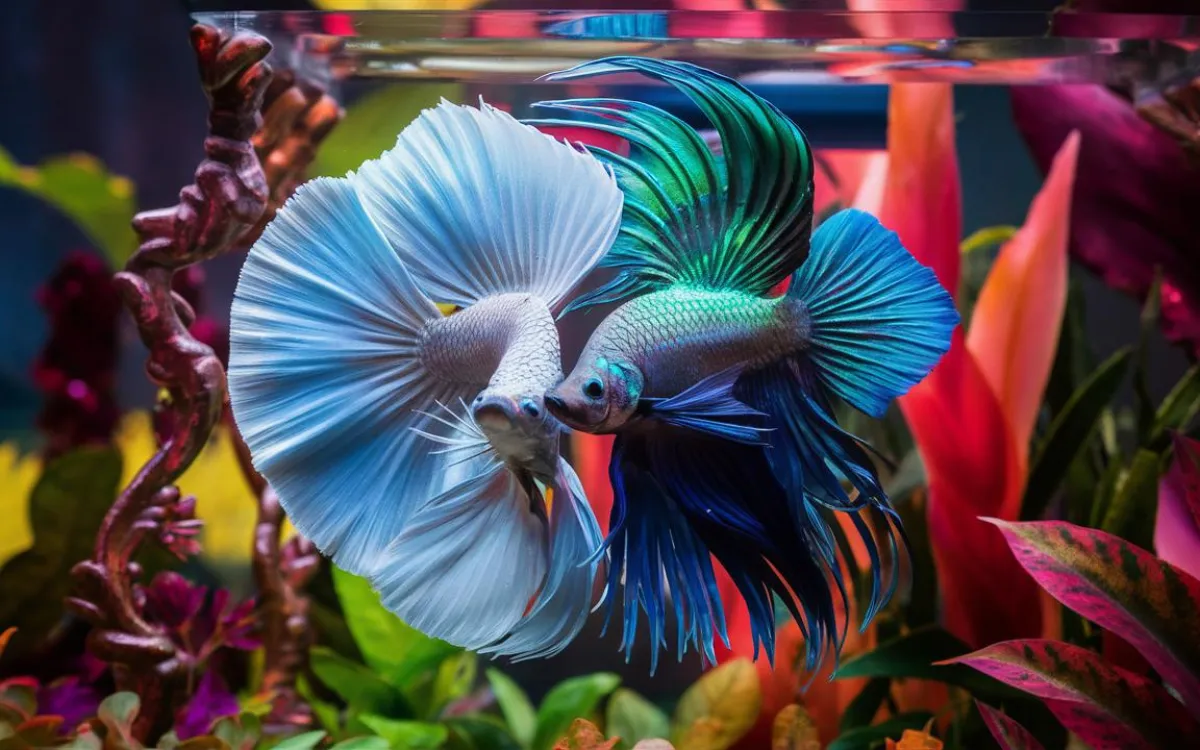Can Male and Female Betta Fish Live Together? The answer might surprise you! While the idea of a harmonious pair might seem appealing, the reality of keeping male and female Betta fish together can be quite challenging.
Betta Fish Information will learn about the unique behaviors of both sexes, the potential risks involved, and the best practices for successful cohabitation.
Can Male and Female Betta Fish Live Together?
Yes, in the sense that you need them together to mate, but to cohabitate you will need a larger fish tank. Because of the aggressive and territorial nature of Betta fish, having both sexes in a small tank can spell disaster, injury, or even death of your fish. Think of it like trying to cram two feuding families into a tiny apartment – it’s a recipe for conflict!
Betta fish come in a variety of colors and patterns, from deep reds and blues to shimmering metallics and intricate marbled designs. They can grow to be about 3 inches long, with some varieties boasting impressive, flowing fins that add to their elegance.
Betta fish prefer warm water, thriving in temperatures between 78-82 degrees Fahrenheit. They can adapt to both fresh and saltwater environments, making them relatively adaptable. These fish are carnivores, enjoying a diet of small insects, larvae, and crustaceans.
While Betta fish are known for their stunning beauty, they are also known for their territorial and aggressive nature towards other Betta fish. This is why they are often kept alone in aquariums, providing them with a space to reign supreme without conflict. However, despite their feisty personality, Betta fish are relatively easy to care for and can live comfortably in smaller spaces, making them a popular choice for beginner aquarists.
Putting A Male and Female Betta Together

While you might think that a male and female of any species are needed for a complete reproductive ecosystem, Betta fish are a bit of an exception. It’s a yes and a no situation.
While male and female Betta fish can technically live together, it’s strongly discouraged. Male Betta fish are notoriously aggressive and territorial, often attacking any fish that enters their space, including females. This fierce nature stems from their natural instinct to defend their territory and compete for dominance.
Imagine trying to put two alpha dogs in the same small yard – it’s a recipe for disaster! The same principle applies to male Betta fish. If you put two males in the same tank, they will likely engage in violent fights for dominance, which can result in serious injury or even death.
Even with a male and female, the territorial nature of Betta fish makes cohabitation risky. While they might initially seem to tolerate each other, a sudden change in mood or a perceived threat can quickly escalate into a fight.
If you’re determined to keep a male and female Betta fish together, you’ll need a very large tank with plenty of hiding places to minimize conflict. You might also consider using a divider to separate them, but even then, there’s no guarantee of peaceful cohabitation.
The safest and most stress-free option for Betta fish is to keep them individually in their own tanks. This allows them to thrive in a comfortable environment without the threat of aggression.
Problems With Keeping Two Sexes Together
While the idea of a male and female Betta fish living harmoniously might seem appealing, the reality is quite different. The biggest hurdle is the male’s aggressive nature. Male Betta fish are highly territorial and will readily attack any fish that enters their space, regardless of gender. This aggressive behavior stems from their natural instinct to defend their territory and compete for dominance.
While female Betta fish can co-exist peacefully in a “sorority” setting (a tank with 4-5 females), introducing a male into this environment can sometimes pacify his aggression. However, even in a sorority, aggression can arise between females during mating season as they compete for dominance and the male’s attention.
Beyond aggression, keeping both sexes together can also negatively impact breeding. Female Betta fish require a peaceful environment to lay eggs properly. When stressed by the presence of a male or other females, they may not lay eggs at all.
Therefore, if you’re aiming to breed your Betta fish, the best approach is to keep them in separate tanks. This provides a stress-free environment for both sexes, allowing them to reach their full potential in terms of health and reproduction.
Conclusion
Ready to take the plunge and explore the world of Betta fish cohabitation? While it’s not always easy, with careful planning and understanding, you can create a peaceful and thriving environment for your Betta pair. Discover more resources and tips on our website to learn about the best practices for successful cohabitation and enjoy the beauty of a harmonious Betta duo.

Related Posts
Can Betta Fish Live With Shrimp? Friends or Foes?
Do Betta Fish Have Teeth? Is Betta Fish Bite Dangerous?
How Long Can A Betta Fish Live Without A Filter? The Facts